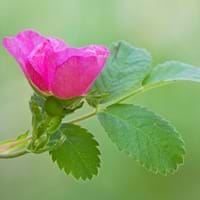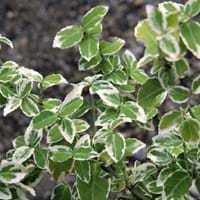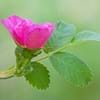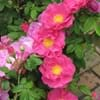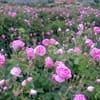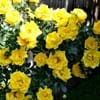Life Span
Perennial
Perennial
Type
Flowering Plants, Ornamental Plant, Perennial
Broadleaf Evergreen
Origin
California, Caribbean, Mexico
China
Types
Not Available
Euonymus fortunei fortunei, Euonymus fortunei radicans, Euonymus fortunei vegetus
Number of Varieties
Not Available
Habitat
Chaparral, Foot Hills, Woodlands
Hedge, Shady Edge, Woodland Garden Dappled Shade
USDA Hardiness Zone
Not Available
5-9
AHS Heat Zone
Not Available
9-2
Sunset Zone
Not available
2b, 3a, 3b, 4, 5, 6, 7, 8, 9, 10, 11, 12, 13, 14, 15, 16, 17
Habit
Upright/Erect
Spreading
Flower Color
Variety of colors
Yellow green
Flower Color Modifier
Bicolor
Not Available
Fruit Color
Non Fruiting Plant
Orange, Pink
Leaf Color in Spring
Gray, Gray Green
Green, Dark Green
Leaf Color in Summer
Gray, Gray Green
Green, Dark Green
Leaf Color in Fall
Gray, Gray Green
Green, Dark Green
Leaf Color in Winter
Gray, Gray Green
Green, Dark Green
Leaf Shape
Pinnate
Elliptic and Ovate
Plant Season
Spring, Summer, Fall
Spring, Summer, Fall, Winter
Sunlight
Full Sun, Partial Sun
Full Sun, Partial Sun, Partial shade, Full Shade
Type of Soil
Loam, Sand
Clay, Loam, Sand
The pH of Soil
Acidic, Neutral
Acidic, Neutral, Alkaline
Soil Drainage
Well drained
Average
Bloom Time
Spring, Late Spring, Early Summer, Summer, Late Summer, Early Fall, Fall
Late Spring, Early Summer
Repeat Bloomer
Not Available
No
Tolerances
Drought
Pollution, Salt, Soil Compaction
Where to Plant?
Container, Ground, Pot
Ground, Pot
How to Plant?
Cuttings
Cuttings, Seedlings, Semi-ripe cuttings
Plant Maintenance
Medium
Low
Watering Requirements
Average Water Needs
Medium
In Summer
Lots of watering
Average Water
In Spring
Moderate
Moderate
In Winter
Average Water
Average Water
Soil pH
Acidic, Neutral
Acidic, Neutral, Alkaline
Soil Type
Loam, Sand
Clay, Loam, Sand
Soil Drainage Capacity
Well drained
Average
Sun Exposure
Full Sun, Partial Sun
Full Sun, Partial Sun, Partial shade, Full Shade
Pruning
Remove damaged leaves, Remove dead branches, Remove dead leaves
Remove damaged leaves, Remove dead branches, Remove dead leaves
Fertilizers
All-Purpose Liquid Fertilizer
since leafy plants, use higher nitrogen content fertilizer
Pests and Diseases
Beetles, Black Spot, Caterpillars, Downy mildew, Mosaic viruses, Powdery mildew, Rust, Scale insects, Thripes
Anthracnose, Aphids, Crown gall, Leaf spot, Soft scales
Plant Tolerance
Drought
Pollution, Salt, Soil Compaction
Flowers
Showy
Insignificant
Flower Petal Number
Double
Single
Edible Fruit
Not Available
No
Foliage Texture
Medium
Medium
Foliage Sheen
Glossy
Glossy
Invasive
Not Available
No
Self-Sowing
Not Available
Yes
Attracts
Birds, Butterflies
Butterflies, Not Available
Allergy
Rash
Not Available
Aesthetic Uses
Showy Purposes
Cottage Garden, Ground Cover
Beauty Benefits
Not Available
Not Available
Environmental Uses
Air purification
Erosion control
Medicinal Uses
Not Available
anti-cancer, Gynaecological
Part of Plant Used
Flowers
Leaves
Other Uses
Oil is used in perfume, soaps, creams, etc.
Used as Ornamental plant
Used As Indoor Plant
Yes
No
Used As Outdoor Plant
Yes
Yes
Garden Design
Container, Cutflower, Feature Plant, Foundation, Mixed Border, Topiary / Bonsai / Espalier
Container, Edging, Foundation, Groundcover, Hedges, Mixed Border, Vine
Botanical Name
Rosa californica
EUONYMUS fortunei
Common Name
California wildrose, California rose
Wintercreeper, Wintercreeper Euonymus
In Hindi
कैलिफोर्निया गुलाब
Wintercreeper
In German
Kalifornische Hecken-Rose
Weißbunte
In French
Le rosier de Californie
wintercreeper
In Spanish
Rosa californica
Wintercreeper
In Greek
Καλιφόρνια αυξήθηκε
Wintercreeper
In Portuguese
California aumentou
wintercreeper
In Polish
California róży
wintercreeper
In Latin
California resurrexit
wintercreeper
Phylum
Magnoliophyta
Magnoliophyta
Class
Magnoliopsida
Magnoliopsida
Order
Rosales
Celastrales
Family
Rosaceae
Celastraceae
Clade
Not Available
Angiosperms, Eudicots, Rosids
Tribe
Not Available
Not Available
Subfamily
Not Available
Celastroideae
Number of Species
Not Available
Importance of California Rose and Wintercreeper
Want to have the most appropriate plant for your garden? You might want to know the importance of California Rose and Wintercreeper. Basically, these two plants vary in many aspects. Compare California Rose and Wintercreeper as they differ in many characteristics such as their life, care, benefits, facts, etc. Every gardener must at least have the slightest clue about the plants he wants to plant in his garden. Compare their benefits, which differ in many ways like facts and uses. The medicinal use of California Rose is Not Available whereas of Wintercreeper is anti-cancer and Gynaecological. California Rose has beauty benefits as follows: Not Available while Wintercreeper has beauty benefits as follows: Not Available.
Compare Facts of California Rose vs Wintercreeper
How to choose the best garden plant for your garden depending upon its facts? Here garden plant comparison will help you to solve this query. Compare the facts of California Rose vs Wintercreeper and know which one to choose. As garden plants have benefits and other uses, allergy is also a major drawback of plants for some people. Allergic reactions of California Rose are Rash whereas of Wintercreeper have Not Available respectively. Having a fruit bearing plant in your garden can be a plus point of your garden. California Rose has no showy fruits and Wintercreeper has showy fruits. Also California Rose is not flowering and Wintercreeper is not flowering . You can compare California Rose and Wintercreeper facts and facts of other plants too.
